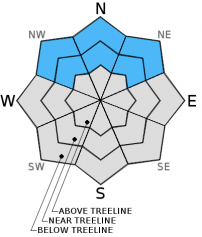| Tuesday | Tuesday Night | Wednesday | |
|---|---|---|---|
| Weather: | Partly cloudy becoming sunny | Clear | Sunny |
| Temperatures: | 41 to 48 deg. F. | 23 to 31 deg. F. | 41 to 48 deg. F. |
| Mid Slope Winds: | Variable | Variable | Variable |
| Wind Speed: | Light | Light | Light |
| Expected snowfall: | 0 | 0 | 0 |
| Tuesday | Tuesday Night | Wednesday | |
|---|---|---|---|
| Weather: | Partly cloudy becoming sunny | Clear | Sunny |
| Temperatures: | 40 to 47 deg. F. | 28 to 34 deg. F. | 40 to 47 deg. F. |
| Ridge Top Winds: | East | East | Variable |
| Wind Speed: | 10-15 mph | 10-15 mph decreasing overnight | Light |
| Expected snowfall: | 0 | 0 | 0 |

























